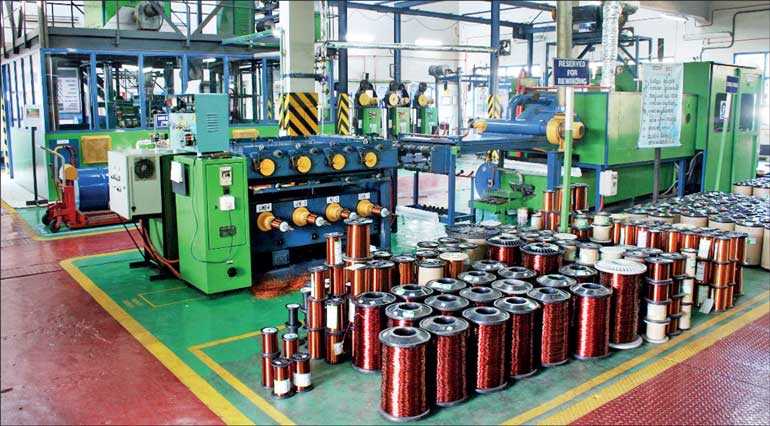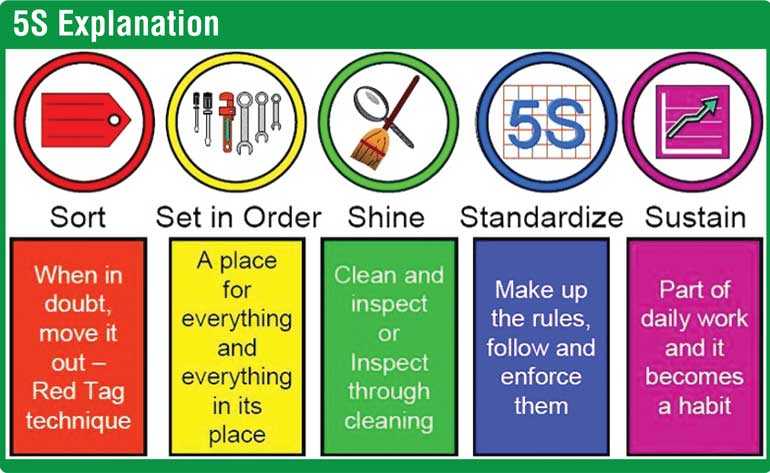Sunday Mar 16, 2025
Sunday Mar 16, 2025
Wednesday, 5 December 2018 00:00 - - {{hitsCtrl.values.hits}}


After many years of experience in the manufacturing industries and successful implementation of lean practices in 60 companies, and five national hospitals, I decided to share my experiences regarding common pitfalls in 5Ss and how to avoid them. 
It is with gratitude I recall the opportunities afforded to me by Japan-Sri Lanka Technical and Cultural Association and the Association for Overseas Technical Scholarship (AOTS) Japan. The training in Japan and the expert guidance that helped me to enhance my own potential and make a positive contribution to improve productivity is highly appreciated.
Collectively along with my clients we were able to raise the standard of the 5S system in Sri Lanka. Many innovative and practical solutions were found to improve the Key Performance Indicators of many companies with excellent corporate results.
Japan Sri Lanka Technical & Cultural Association (JASTECA) is conducting the annual 5S competition for 2018 and it has successfully conducted the 5S competition for the last 22 years. It is open to the private and public sectors and has become a much sought after competition. I thought it is the most opportune time to publish this article. JASTECA must be commended for its effort to have continuously conducting this competition without a break and to date around 1,200 companies have participated.
Since incorporating M&S Associates (consultants) we successfully implemented 5S, Kaizen, Lean and several Japanese management techniques with excellent corporate results. We saw dramatic changes in production, quality, cost, delivery, safety and morale in many of these companies. They won many national and international awards.
Lesson No. 1: 5S is not just housekeeping
My initial comprehension was that it is simply a method for improving organisation and housekeeping. I figured that it was typically the first tool introduced in a Lean transformation because it was easy to wrap one’s mind around, and was relatively safe that no person’s job was impacted too drastically.
On the plus side 5S resulted in an immediate visual impact and eliminated the waste and frustration associated with employees searching for needed items. Thus, I saw it simply as a momentum builder and encourages team work.
While 5S is indeed a tool for improving workplace cleanliness, but its potential to improve key performance indicators such as production, quality, cost, delivery, safety and morale, etc. are enormous.
In many of my presentations on 5S we have explained the need to understand the concept and the importance of relating it to one’s daily activities from the time you wake up in the morning. It is a way of life and how you set the day’s work ahead of you at home and at work.
To fully appreciate the fundamental nature of 5S to any Lean transformation, I find it useful to start with a little arithmetic; 3S + 2S = 5S.
The first three components of 5Ss are indeed about housekeeping. The fourth and the fifth Ss, however, are about establishing a culture of discipline around standard work. It is this reason that 5S is a foundational tool for all Lean transformations. Without establishing a culture that demonstrates the ability to establish standard work and sustain improvements, all future Lean progress will ultimately be a failure. In fact the Japanese lean experts believe this so strongly that they refuse to let clients take the next step in the process until they have successfully demonstrated 5S for two years.
My own experience with many local clients is that we have allowed them to commence other Lean initiatives only on completion of 5S and good audit results exceeding 80% effectiveness.
Lesson No. 2: 5S is simple… but it’s not easy; the ideals of 5S are not complex
Keep only what is needed at the workplace; keep it clean; store it in the most convenient location; establish clear, visual expectations for everyone to keep it in that condition; and hold people accountable to those expectations.
But let’s not confuse simplicity (the lack of complexity) with ease requiring little attention or lease effort. One needs to practice with commitment and consistency. The key word here is consistency. In the incredibly competitive business environment the managers should work with a high level of consistency in order to survive and face the challenges courageously.
Likewise, what makes 5S sustainment so difficult is the consistency with which it must be applied. In short, each and every instance of nonconformity that is identified must be addressed. Anything short of that allows for doubt and mixed signals to the workforce. One company was so good at this and their weekly audits proved to be a total success. They addressed all nonconformities highlighted by the audit teams.
A factory or office successfully practicing 5Ss makes it look effortless. The successful 5S organisations are committed to constant and continuous sorting, shining and setting in order. More importantly those organisations have the courage to risk episodes of interpersonal discomfort when a team member fails to live up to agreed standards. Fortunately, all of the skills required for a flourishing 5s organisation can be learned and successfully applied if the desire exists. No innate traits are required.
“Like almost all things requiring discipline (healthy diet, exercise, saving) 5S is easy to understand but difficult to practice. Communication should not over simplify the challenge. Ensure the organisation understands the importance and magnitude of the effort. Start small, recognise successes, and leverage to larger areas.”
Lesson No. 3: 5S is not an event, it’s a process
Organisations often kick off their lean implementations with basic training and perhaps a short 5S Kaizen focused on the initial clean-up of a scoped area.” Before” and “After” photos are taken to document the significant change, and almost everyone leaves feeling like they’ve accomplished something.
Those good feelings, however, quickly erode to scepticism if the fourth and the fifth Ss are not practiced (Seiketsu and Shitsuke).The result is that the condition of the area steadily degrades, pulling down employees pride and enthusiasm with it. The entire Lean effort can be perceived as another program of the month.
While a 5S Kaizen event is a possible trailhead for a continuous improvement Journey, great care must be taken in planning the event to ensure that all five components are adequately emphasised. Often, 5S Kaizen agendas allot 80-90%, sometimes more, of the scheduled time to sort, showcase, and set in order. Standardisation and sustenance are treated as afterthoughts. This reinforces the myth that 5S is only about housekeeping and sets the continuous improvement journey off on precarious first leg.
A better allotment is to spend an equal amount of time on the final two components as is spent on the first three components. Dedicated time should be assigned to document expectations. Photos of both acceptable and unacceptable levels should be included. Also ensure that fixed point photos taken before and after improvements. In addition, agreement should be reached on how team members will satisfy expectations: Will 5s time be designated each shift? Does adequate time exist within machine cycles to perform the necessary tasks?
An adequate portion of the agenda should also be devoted to developing the fifth S (Shitsuke).Team members must articulate their expectations of each other and practice holding each other accountable. Standard work for supervisors is recommended so that their role is clear in addressing out- of-control situations. An audit process and visual management to monitor sustainment by the team and their supervisor must be developed, including leadership’s duty to hold the supervisor accountable.
Finally, an agreed-to system should be established for making improvements to the initial standards as team members identify better locations for sorting, more efficient methods for cleaning and disposal etc. Items not needed are stored in the “Red Tag Corner”. These items are disposed of at regular intervals.
Review 5S Kaizen pre- work to ensure the appropriate time and emphasis is placed on the standardisation and sustaining components. Reinforce the importance of these components in kick-off comments, during the event, and at the reporting the progress. Recognise the improvements by refraining from “mission accomplished” type comments. Take an active role in auditing the audits.
Lesson No.4: 5S success depends almost entirely on leadership
Progressive leaders may often roll up their sleeves to help during the initial clean up or big Seiri day. In reality however, leadership’s real work begins when the initial clean-up is completed.
That’s because only leadership can ensure that a culture values the standardisation and sustainment within their organisation. Until those values are imbedded within the workforce, pursuing other lean tools which have an even greater impact on how work is accomplished (change-over, one-piece flow, TPM) is fruitless.
For this reason it’s important that all leaders, from front-line supervisors, to the senior leadership team members, understand their role in a continuous Improvement transformation. While a basic understanding of Lean principles is important, a clear image of leadership’s responsibilities in the Lean environment is absolutely vital.
One manager, upon hearing of the importance of auditing for improvement complained: “I’m not interested in becoming a babysitter.” One can wonder how someone in a leadership role capable of making such a remark could succeed in any organisation, Lean or not. The point is, a key leadership responsibility in any setting – business, sports, charity – involves holding people accountable to the ideals and goals of the organisation.
If the organisation has not previously established a healthy results-oriented culture, leaders should be trained on coaching and holding employees accountable prior to embarking on 5S initiatives. Properly interacting with employees to provide feedback, both positive and negative, is the responsibility of a good leader.
Hopefully an organisation eventually matures to a point where team members hold each other accountable to collectively established set of standards. This level will never be reached without leadership first modelling the behaviour.
Lesson No.5: Each 5S component has a common pitfall (learn to avoid them)
My experience with 5S implementation has revealed that there are very common mistakes. By being aware of these mistakes, the prudent leader can proactively design and implementation to ensure that their organisation’s execution is successful.
In the SEIRI stage, companies often underestimate the critical nature of an effective, ongoing Red Tag process. It’s very hard for some people to part with items they believe have value, even though that value may not pertain to the area undergoing 5S initiatives. A working Red Tag process offers these people a means of getting the item out of their area, while still recycling it to a place where it can add value.
A common flaw in the initial stage is not setting a high enough standard for the team. As a result many initial stages of 5Ss end up as pure cleaning and clearing only. The objective here is to restore the area to a good as new condition and may involve painting, rearranging, aligning, restoring the floor. Leaving more space than required to store only necessary items is a frequent oversight with the set in order stage.
There is some truth which can be applied to the work area from Boston’s irreversible law of clutter which states that in any household, junk accumulates to fit the space available for its storage.
In the standardisation stage, I often see standards that are too vague to be useful for anyone other than the author of the standards. Clear and precise Standards should include visual examples of both acceptable and unacceptable levels of adherence.
Finally leaders make unfounded assumptions in the sustenance stage that all team members are not on board and excited to comply with the new standards of the organisation. The sad truth is that some people are very comfortable living in total disarray and return to it each day after work.
Learn from other’s mistakes
Lesson No. 6: 5S isn’t important… it’s essential!
The most common rationale for 5S is that an organised workplace improves safety, quality, productivity and morale. These are good arguments, and they were enough to convince me that 5S was important, and worth doing. But now with more than 27 years’ experience, I know that 5S is more than important, it’s essential for continuous improvement. Here’s why:
Standardise and sustain are discipline dependant ideals. It’s easy to sort, Showcase, and set in order, but to maintain the efficiencies that are created, People have to behave differently than they did in the past. It would be nice if behaviours would just change automatically, but it usually doesn’t work that Way. It takes influence to change behaviours that have developed over time. It isn’t always easy, but it can be done by leaders who have the skills and courage to do so.
So here’s my point. Leaders who know how to standardise and sustain by instilling discipline are well equipped to effectively utilise tools for continuous improvement. Why? Because all lean tools are also discipline dependant. Here are a few examples:
When we create standard work we identify the best practices and document them as the standard for everyone to follow. Will they follow them just because we have created a standard? Probably not. As with 5S, we have to ensure people are following the standards in order to sustain the improvements we make. Many have successfully used the SDCA cycle to ensure that the standards are adhered to (standardise, do, check, action).
Kanban is a fantastic tool to improve supply chain performance, but like 5S, and standard work, it requires discipline. Kanban cards must be moved at the right time and get filled in the right order for the system to work. Calculations must be regularly reviewed. These actions, while simple, are essential and require discipline.
With Total Productive Maintenance (TPM), we identify what needs to be done proactively and routinely to ensure that equipment is reliable and productive. People who are assigned TPM tasks are essential to the success of the TPM program. Their behaviours need to change after the TPM event has been completed.
[The writer is Director/Chief Executive Officer, Kelani Cables Plc, and commands 50 plus years’ experience in management of several industries. He has held senior positions in the private sector with outstanding performances and effective resource utilisation. He is an alumnus of the Association for Overseas Technical Scholarships (AOTS), Japan. He has attended four Management Training Programs in Japan and has helped 60 companies and five national hospitals using the key learnings from these programs to enhance their productivity. He was the first to implement the 5S system in Sri Lanka in a private company way back in 1989. He is a Past President and Trustee of Japan Sri Lanka Technical and Cultural Association (JASTECA), Past President of the Association for International Standards (AIS) and Member of the Advisory Board to the Sri Lanka Association for Quality & Productivity.]
Discover Kapruka, the leading online shopping platform in Sri Lanka, where you can conveniently send Gifts and Flowers to your loved ones for any event including Valentine ’s Day. Explore a wide range of popular Shopping Categories on Kapruka, including Toys, Groceries, Electronics, Birthday Cakes, Fruits, Chocolates, Flower Bouquets, Clothing, Watches, Lingerie, Gift Sets and Jewellery. Also if you’re interested in selling with Kapruka, Partner Central by Kapruka is the best solution to start with. Moreover, through Kapruka Global Shop, you can also enjoy the convenience of purchasing products from renowned platforms like Amazon and eBay and have them delivered to Sri Lanka.
Discover Kapruka, the leading online shopping platform in Sri Lanka, where you can conveniently send Gifts and Flowers to your loved ones for any event including Valentine ’s Day. Explore a wide range of popular Shopping Categories on Kapruka, including Toys, Groceries, Electronics, Birthday Cakes, Fruits, Chocolates, Flower Bouquets, Clothing, Watches, Lingerie, Gift Sets and Jewellery. Also if you’re interested in selling with Kapruka, Partner Central by Kapruka is the best solution to start with. Moreover, through Kapruka Global Shop, you can also enjoy the convenience of purchasing products from renowned platforms like Amazon and eBay and have them delivered to Sri Lanka.